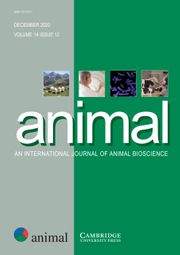Article contents
Soybean oil and linseed oil supplementation affect profiles of ruminal microorganisms in dairy cows
Published online by Cambridge University Press: 10 July 2009
Abstract
The objective of this study was to evaluate changes in ruminal microorganisms and fermentation parameters due to dietary supplementation of soybean and linseed oil alone or in combination. Four dietary treatments were tested in a Latin square designed experiment using four primiparous rumen-cannulated dairy cows. Treatments were control (C, 60 : 40 forage to concentrate) or C with 4% soybean oil (S), 4% linseed oil (L) or 2% soybean oil plus 2% linseed oil (SL) in a 4 × 4 Latin square with four periods of 21 days. Forage and concentrate mixtures were fed at 0800 and 2000 h daily. Ruminal fluid was collected every 2 h over a 12-h period on day 19 of each experimental period and pH was measured immediately. Samples were prepared for analyses of concentrations of volatile fatty acids (VFA) by GLC and ammonia. Counts of total and individual bacterial groups (cellulolytic, proteolytic, amylolytic bacteria and total viable bacteria) were performed using the roll-tube technique, and protozoa counts were measured via microscopy in ruminal fluid collected at 0, 4 and 8 h after the morning feeding. Content of ruminal digesta was obtained via the rumen cannula before the morning feeding and used immediately for DNA extraction and quantity of specific bacterial species was obtained using real- time PCR. Ruminal pH did not differ but total VFA (110 v. 105 mmol/l) were lower (P < 0.05) with oil supplementation compared with C. Concentration of ruminal NH3-N (4.4 v. 5.6 mmol/l) was greater (P < 0.05) due to oil compared with C. Compared with C, oil supplementation resulted in lower (P < 0.05) cellulolytic bacteria (3.25 × 108v. 4.66 × 108 colony-forming units (CFU)/ml) and protozoa (9.04 × 104v. 12.92 × 104 cell/ml) colony counts. Proteolytic bacteria (7.01 × 108v. 6.08 × 108 CFU/ml) counts, however, were greater in response to oil compared with C (P < 0.05). Among oil treatments, the amount of Butyrivibrio fibrisolvens, Fibrobacter succinogenes and Ruminococcus flavefaciens in ruminal fluid was substantially lower (P < 0.05) when L was included. Compared to C, the amount of Ruminococcus albus decreased by an average of 40% regardless of oil level or type. Overall, the results indicate that some ruminal microorganisms, except proteolytic bacteria, are highly susceptible to dietary unsaturated fatty acids supplementation, particularly when linolenic acid rich oils were fed. Dietary oil effects on ruminal fermentation parameters seemed associated with the profile of ruminal microorganisms.
- Type
- Full Paper
- Information
- Copyright
- Copyright © The Animal Consortium 2009
Footnotes
These authors contribute equally.
References
- 122
- Cited by


